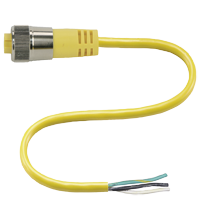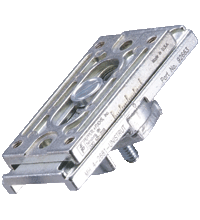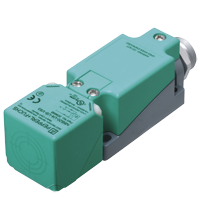Please note: All product-related documents, such as certificates, declarations of conformity, etc., which were issued prior to the conversion under the name Pepperl+Fuchs GmbH or Pepperl+Fuchs AG, also apply to Pepperl+Fuchs SE.
Download the complete datasheet as a PDF:
Datasheet excerpt: Technical data of
NBB20-U4-US-V93P
| General specifications |
| Switching function | Normally open (NO) |
| Output type | Two-wire |
| Rated operating distance | 20 mm |
| Installation | flush |
| Output polarity | AC/DC |
| Assured operating distance | 0 ... 16.2 mm |
| Actual operating distance | 18 ... 22 mm |
| Reduction factor rAl | 0.4 |
| Reduction factor rCu | 0.3 |
| Reduction factor r304 | 0.77 |
| Reduction factor rFe | 1 |
| Reduction factor rBrass | 0.43 |
| Output type | 2-wire |
| Nominal ratings |
| Switching frequency | AC, 0 ... 30 Hz
DC, 0 ... 100 Hz |
| Hysteresis | 1 ... 10 typ. 5 % |
| Reverse polarity protection | reverse polarity tolerant |
| Short-circuit protection | pulsing |
| Voltage drop | ≤ 5 V (typ. 2V) DC operation
≤ 8 V (typ. 2V) AC operation |
Momentary current
(20 ms, 0.1 Hz) | 0 ... 3000 mA |
| Operating current | 5 ... 500 mA |
| Off-state current | ≤ 1.5 mA |
| Time delay before availability | ≤ 300 ms |
| Operating voltage indicator | LED, green |
| Switching state indicator | LED, yellow |
| Error indicator | flashes when overcurrent |
| Functional safety related parameters |
| MTTFd | 540 a |
| Mission Time (TM) | 20 a |
| Diagnostic Coverage (DC) | 0 % |
| Electrical specifications |
| Rated operating voltage | 24 ... 250 V DC / 24 ... 230 V AC |
| Operating voltage | 20 ... 300 V DC / 20 ... 253 V AC |
| Compliance with standards and directives |
| Standard conformity | |
| Standards | EN IEC 60947-5-2 |
| Approvals and certificates |
| Protection class | I |
| Rated insulation voltage | 230 V |
| Rated impulse withstand voltage | 2.5 kV |
| Ambient conditions |
| Ambient temperature | -25 ... 85 °C (-13 ... 185 °F) |
| Storage temperature | -25 ... 85 °C (-13 ... 185 °F) |
| Mechanical specifications |
| Connection type | Connector plug V93 |
| Cable gland | |
| Note | terminal compartment - resin filled |
| Housing material | PA 6.6 / metal |
| Sensing face | PA 6.6 |
| Housing base | metal / class I equipment with ground connection |
| Degree of protection | IP67 |
| Mass | 298 g |
| Dimensions | |
| Height | 40 mm |
| Width | 40 mm |
| Length | 118 mm |
Classifications
| System | Classcode |
| ECLASS 13.0 | 27274001 |
| ECLASS 12.0 | 27274001 |
| ECLASS 11.0 | 27270101 |
| ECLASS 10.0.1 | 27270101 |
| ECLASS 9.0 | 27270101 |
| ECLASS 8.0 | 27270101 |
| ECLASS 5.1 | 27270101 |
| ETIM 9.0 | EC002714 |
| ETIM 8.0 | EC002714 |
| ETIM 7.0 | EC002714 |
| ETIM 6.0 | EC002714 |
| ETIM 5.0 | EC002714 |
| UNSPSC 12.1 | 39121550 |
Details:
NBB20-U4-US-V93P
Design / Simulation:
NBB20-U4-US-V93P
Approvals:
NBB20-U4-US-V93P
Associated Products:
NBB20-U4-US-V93P
| Accessories |

|
|
|
| Modular mounting bracket fa |
|

|
|
|
| Female cordset, 7/8", 3-pin, STOOW cablefa |
|

|
|
|
| Mounting aidfa |
|














 +49 621 776-0
+49 621 776-0